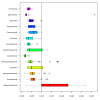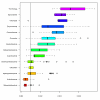Stretches of alternating pyrimidine/purines and purines are respectively linked with pathogenicity and growth temperature in prokaryotes
- PMID: 19646265
- PMCID: PMC2728739
- DOI: 10.1186/1471-2164-10-346
Stretches of alternating pyrimidine/purines and purines are respectively linked with pathogenicity and growth temperature in prokaryotes
Abstract
Background: The genomic fractions of purine (RR) and alternating pyrimidine/purine (YR) stretches of 10 base pairs or more, have been linked to genomic AT content, the formation of different DNA helices, strand-biased gene distribution, DNA structure, and more. Although some of these factors are a consequence of the chemical properties of purines and pyrimidines, a thorough statistical examination of the distributions of YR/RR stretches in sequenced prokaryotic chromosomes has to the best of our knowledge, not been undertaken. The aim of this study is to expand upon previous research by using regression analysis to investigate how AT content, habitat, growth temperature, pathogenicity, phyla, oxygen requirement and halotolerance correlated with the distribution of RR and YR stretches in prokaryotes.
Results: Our results indicate that RR and YR-stretches are differently distributed in prokaryotic phyla. RR stretches are overrepresented in all phyla except for the Actinobacteria and beta-Proteobacteria. In contrast, YR tracts are underrepresented in all phyla except for the beta-Proteobacterial group. YR-stretches are associated with phylum, pathogenicity and habitat, whilst RR-tracts are associated with phylum, AT content, oxygen requirement, growth temperature and halotolerance. All associations described were statistically significant with p < 0.001.
Conclusion: Analysis of chromosomal distributions of RR/YR sequences in prokaryotes reveals a set of associations with environmental factors not observed with mono- and oligonucleotide frequencies. This implies that important information can be found in the distribution of RR/YR stretches that is more difficult to obtain from genomic mono- and oligonucleotide frequencies. The association between pathogenicity and fractions of YR stretches is assumed to be linked to recombination and horizontal transfer.
Figures




Similar articles
-
Bias of purine stretches in sequenced chromosomes.Comput Chem. 2002 Jul;26(5):531-41. doi: 10.1016/s0097-8485(02)00013-x. Comput Chem. 2002. PMID: 12144181
-
The ordering of nucleotides in the DNA: strong pyrimidine-purine patterns near homooligomer tracts.J Theor Biol. 1991 Mar 7;149(1):21-42. doi: 10.1016/s0022-5193(05)80069-4. J Theor Biol. 1991. PMID: 1881144
-
Unusual frequencies of certain alternating purine-pyrimidine runs in natural DNA sequences: relation to Z-DNA.FEBS Lett. 1985 Jun 3;185(1):197-202. doi: 10.1016/0014-5793(85)80769-9. FEBS Lett. 1985. PMID: 3996596
-
Hypermodified bases in DNA.FASEB J. 1995 Aug;9(11):1034-42. doi: 10.1096/fasebj.9.11.7649402. FASEB J. 1995. PMID: 7649402 Review.
-
Genomes and DNA conformation.Biol Chem. 1997 Dec;378(12):1397-404. doi: 10.1515/bchm.1997.378.12.1397. Biol Chem. 1997. PMID: 9461338 Review.
Cited by
-
The structural code of cyanobacterial genomes.Nucleic Acids Res. 2014 Aug;42(14):8873-83. doi: 10.1093/nar/gku641. Epub 2014 Jul 23. Nucleic Acids Res. 2014. PMID: 25056315 Free PMC article.
-
Assessing diversity of DNA structure-related sequence features in prokaryotic genomes.DNA Res. 2014 Jun;21(3):285-97. doi: 10.1093/dnares/dst057. Epub 2014 Jan 9. DNA Res. 2014. PMID: 24408877 Free PMC article.
-
Association of purine asymmetry, strand-biased gene distribution and PolC within Firmicutes and beyond: a new appraisal.BMC Genomics. 2014 Jun 4;15(1):430. doi: 10.1186/1471-2164-15-430. BMC Genomics. 2014. PMID: 24899249 Free PMC article.
-
The nucleotide composition of microbial genomes indicates differential patterns of selection on core and accessory genomes.BMC Genomics. 2017 Feb 10;18(1):151. doi: 10.1186/s12864-017-3543-7. BMC Genomics. 2017. PMID: 28187704 Free PMC article.
-
Simple structural differences between coding and noncoding DNA.PLoS One. 2011 Feb 3;6(2):e14651. doi: 10.1371/journal.pone.0014651. PLoS One. 2011. PMID: 21304908 Free PMC article.
References
-
- Sinden RR. DNA Structure and Function. Academic Press; San Diego; 1994.
Publication types
MeSH terms
Substances
LinkOut - more resources
Full Text Sources

